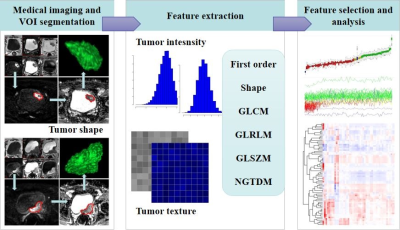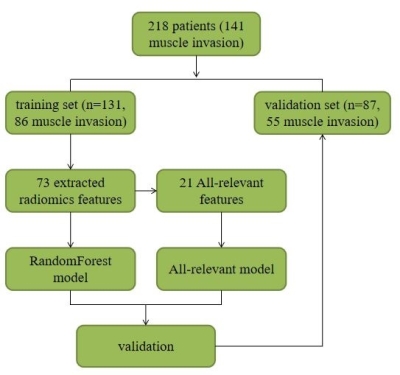guiqin Liu1, shuaishuai XU1, yongming Dai2, Guangyu WU1, and jianrong XU1
1Radiology, Renji Hospital,Shanghai Jiaotong University School of Medicine, Shanghai, China, 2United Imaing Healthcare, Shanghai, China
1Radiology, Renji Hospital,Shanghai Jiaotong University School of Medicine, Shanghai, China, 2United Imaing Healthcare, Shanghai, China
Purpose: To investigate
the value of radiomics features from diffusion-weighted imaging (DWI) in
differentiating muscle-invasive bladder cancer (MIBC) from non-muscle-invasive
bladder cancer (NMIBC).
Methods: This retrospective study included
218 pathologically-confirmed bladder cancer patients (training set: 131
patients, 86 MIBC; validation set: 87 patients, 55 MIBC) who underwent DWI
before biopsy through transurethral resection (TUR) between July 2014 and December 2018. Radiomics models based on DWI for discriminating state
of muscle-invasive were built using random forest (RF) and all-relevant (AR)
methods on the training set and were tested on validation set. Combination
models based on TUR data were also built. Discrimination performances were
evaluated with the area under the receiver operating characteristic (ROC) curve
(AUC), accuracy, sensitivity, specificity, F1 and F2 scores. Qualitative MRI
evaluation based on morphology was performed for comparison.
Results: No significant difference was found between
RF and AR models. RF model was more sensitive than TUR (0.873 vs 0.655, p=0.019)
for discriminating muscle-invasive bladder cancer. When combining RF with TUR,
the sensitivity increased to 0.964, significantly higher than TUR (0.655, p<0.001),
MRI evaluation (0.764, p=0.006), and the combination of TUR and MRI (0.836, p=0.046).
Combining RF and TUR achieved the highest accuracy of 0.897 and F2 score of
0.946.
Conclusion: Combining
DWI radiomics features with TUR could improve the sensitivity and accuracy in
discriminating the presence of muscle invasion in bladder cancer for clinical
practice. Multi-center, prospective studies are needed to confirm our results.


